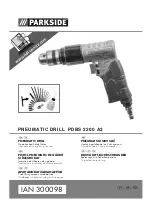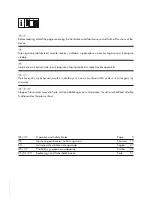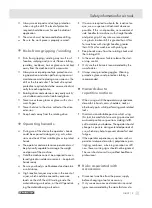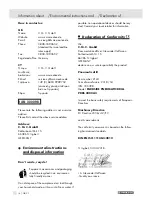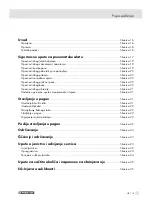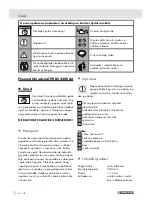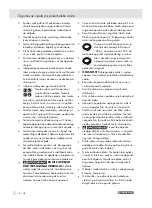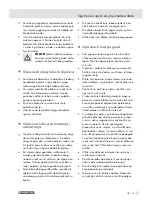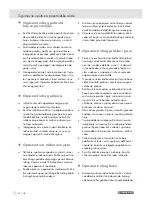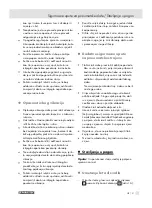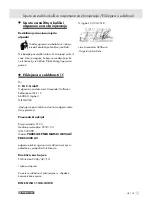
11
GB/CY
Safety information for air tools / Commissioning
If you notice your skin on fingers or hands beco-
ming numb, tingling, hurting or becoming white,
stop working with the machine and consult a
physician.
Operate and maintain the drill as recommen-
ded in this manual to prevent an unnecessary
increase in vibration.
Do not allow the drill to rattle on the material,
as this will most likely significantly increase vi-
bration.
Do not use work or poorly fitting sockets or ex-
tensions, as these are very likely to significantly
increase vibration.
Select, maintain and replace consumables and
machine tools as recommended in these in-
structions to prevent an unnecessary increase
in vibration.
Whenever possible, use a stand, clamp or an
equaliser to support the weight of the machine.
Do not grip the machine too tightly but firmly,
maintaining the necessary hand reaction forces,
as the vibration hazard typically increases when
tightening the grip.
Additional safety instructions
for pneumatic machinery
Compressed air can result in serious injuries.
- Always close the air supply, release pressure
from the hose, and disconnect the machine
from the compressed air supply when the ma-
chine is not in use, before switching accesso-
ries or when performing repairs.
- Never aim the air flow at yourself or others.
Hoses flapping about can result in serious inju-
ries. Therefore always inspect hoses and their
fasteners for damage and a secure fit.
Direct cold air away from hands.
If using universal swivel couplings (coupling
discs) always use locking pins and use whip-
check hose safety cables for protection in the
event the connection between the hose and the
machine or in between hoses fail.
Be sure not to exceed the maximum pressure
specified on the machine.
Never carry pneumatic tools by the hose.
Commissioning
Note:
The device is fully functional as delivered.
Inserting the bit or drill
Loosen the keyed chuck
1
using the wrench
9
(see Fig. A).
Now insert the bit extension
10
as far as possi-
ble into the keyed chuck
1
and attach the
bit
11
(see Fig. A).
To secure the bit extension
10
, tighten the
keyed chuck
1
using the wrench
9
(see Fig. B).
Ensure the bit extension
10
and the bit
11
are
seated securely. Insert the drill as in these steps
(see Fig. A and C).
Connecting
Note:
only use connection hoses with a minimum
inside diameter of 9 mm.
Wrap the coupler
8
with Teflon tape (not in-
cluded) before screwing it into the compressed
air unit. Wrap the tape around the thread as
tight as possible. This will minimise the likeli-
hood of air leaking and optimise the work
process.
Screw the plug nipple
8
into the connection
thread of the power drill (see Fig. D).
Tighten the connection using a pair of pliers.
Now attach the air hose to the plug nipple
8
using some force until the hose locks into
place.
ATTENTION!
Ensure that the com-
pressed air hose is firmly seated. A
loose hose whipping about out of
control presents a major hazard. Also ensure
the two screw connections between the coup-
ling and device are secure.
Summary of Contents for PDBS 2200 A3
Page 3: ......
Page 4: ......
Page 26: ...26...
Page 38: ...38...
Page 40: ...40 GR CY PDBS 2200 A3 1 2 3 4 5 6 7 8 9...
Page 42: ...42 GR CY...
Page 43: ...43 GR CY 6 8 bar 125 psi 150 6 8 bar...
Page 44: ...44 GR CY 4Nm 10Nm...
Page 45: ...45 GR CY...
Page 46: ...46 GR CY...
Page 47: ...47 GR CY 1 9 A 10 1 11 A 10 1 9 B 10 11 A C 9mm 8 8 D 8 6 8bar...
Page 48: ...48 GR CY 10m 9mm 0 6 bar 3 3 4 4 F 4 R 5 3 8 SAE10 20 a 8...
Page 49: ...49 GR CY b 3 5 5 10 5 Creative Marketing Consulting GmbH 3 O 2251 1994...
Page 52: ...52...

